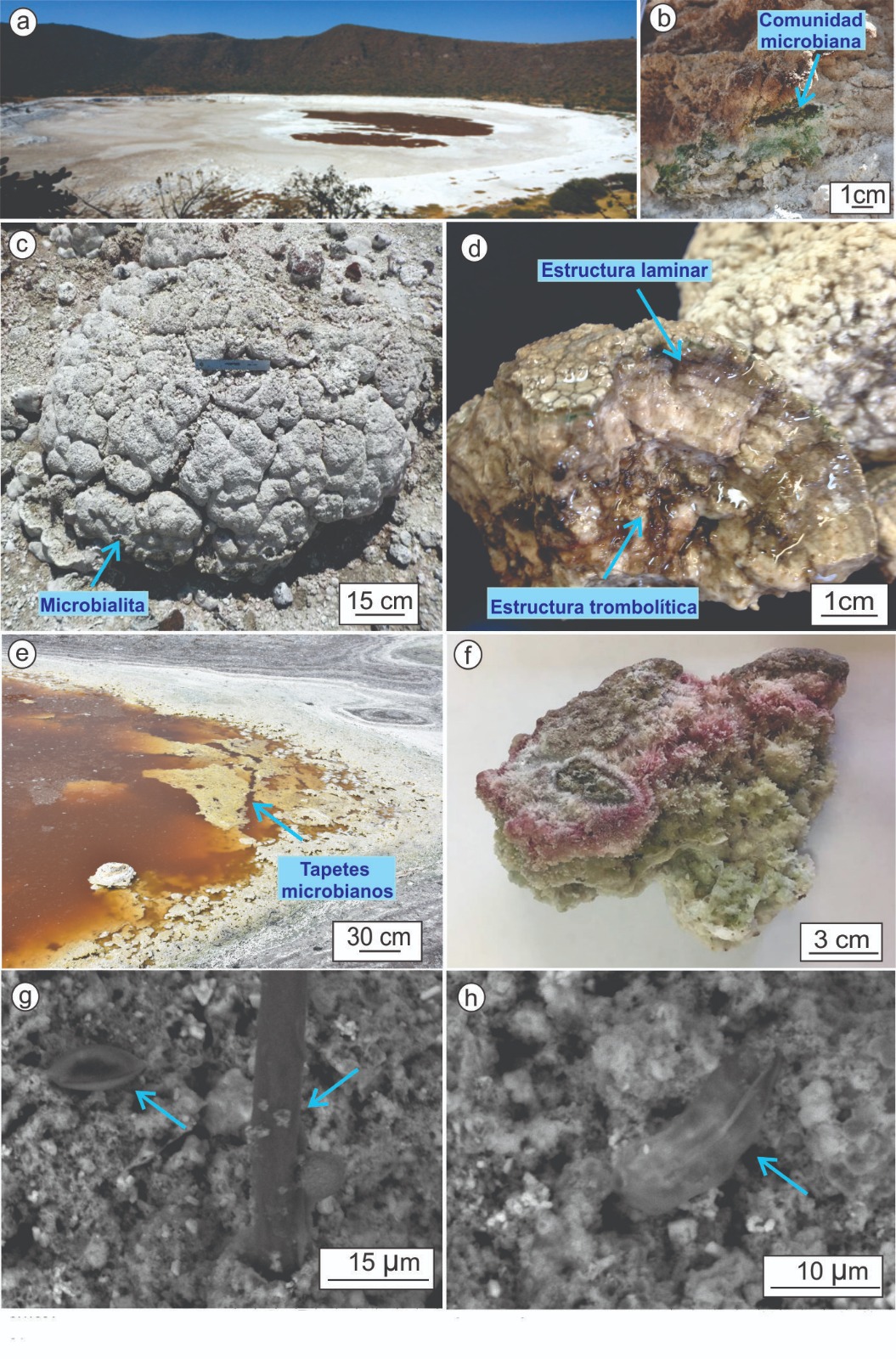Abstract
On Earth, some microorganisms that live defying the limits of life as we know it are called "extremophiles". Until recently, it was believed that life was only capable of developing under certain conditions. But in recent years, scientists around the world have found microscopic life growing in extreme environmental conditions. In Earth history, extremophile microorganisms have left their mark in the form of fossil microbialites. At present, these small beings still participate in the formation of microbialites in many parts of the world. In Mexico they have been reported in several places, such as volcanic crater lakes in the center of the country and Rincón de Parangueo is one of them. The Rincón de Parangueo crater lake is the product of a phreatomagmatic explosion, which until a few decades ago contained a perennial lake inside, unfortunately, human activities have contributed to the water level decrease. The gradual desiccation of the lake has been accompanied by a significant increase in the salinity and pH of the water, providing an extreme environment for the development of extremophile microbial life. Within the crater, microbial communities precipitate carbonates as part of their biological activity, contributing to the formation of microbialites. Geobiological studies carried out in different areas of the crater have reported microbial communities capable of surviving the extreme conditions of the place. The development of extremophile microbial communities has been documented mainly in three areas of the crater: 1) the former lake shoreline, 2) remnant pools, and 3) deep lake sediments. The development of extremophile microorganisms in such peculiar environments as Rincón de Parangueo is of special importance to understand the origin, evolution, and distribution of life on Earth. In addition, they are a source of scientific and technological knowledge that can be applied in the search for life on other planets with extreme characteristics similar to those identified on Earth.
References
Altermann, W. (2008). Accretion, trapping and binding of sediment in Archean stromatolites—morphological expression of the antiquity of life. Space Science Reviews, 135(1), 55-79.
Allwood, A. C., Walter, M. R., Kamber, B. S., Marshall, C. P., y Burch, I. W. (2006). Stromatolite reef from the Early Archaean era of Australia. Nature, 441(7094), 714-718.
Aranda-Gómez, J. J., Levresse, G., Pacheco Martínez, J., Ramos-Leal, J. A., Carrasco-Núñez, G., Chacón-Baca, E. y Noyola-Medrano, C. (2013). Active sinking at the bottom of the Rincón de Parangueo Maar (Guanajuato, México) and its probable relation with subsidence faults at Salamanca and Celaya. Boletín de la Sociedad Geológica Mexicana, 65(1), 169-188.
Aranda-Gómez, J. J., Cerca, M., Rocha-Treviño, L., Carrera-Hernández, J. J., Levresse, G., Pacheco, J. y Beraldi-Campesi, H. (2017). Structural evidence of enhanced active subsidence at the bottom of a maar: Rincón de Parangueo, México. Geological Society, London, Special Publications, 446(1), 225-254.
Armienta, M. A., Vilaclara, G., De la Cruz-Reyna, S., Ramos, S., Ceniceros, N., Cruz, O. y Arcega-Cabrera, F. (2008). Water chemistry of lakes related to active and inactive Mexican volcanoes. Journal of Volcanology and Geothermal Research, 178(2), 249-258.
Casanova, J. (1986). East African rift stromatolites. Geological Society, London, Special Publications, 25(1), 201-210.
Combie, J., y Runnion, K. (1996). Looking for diversity of Yellowstone extremophiles. Journal of industrial microbiology and biotechnology, 7(3-4), 214-218.
Connon, S. A., Lester, E. D., Shafaat, H. S., Obenhuber, D. C., y Ponce, A. (2007). Bacterial diversity in hyperarid Atacama Desert soils. Journal of Geophysical Research: Biogeosciences, 112(G4).
Crowley, D. J., Boubriak, I., Berquist, B. R., Clark, M., Richard, E., Sullivan, L., y McCready, S. (2006). The uvrA, uvrB and uvrC genes are required for repair of ultraviolet light induced DNA photoproducts in Halobacterium sp. NRC-1. Saline systems, 2, 1-13.
DasSarma, S., y DasSarma, P. (2017). Halophiles. eLS, 1-13.
Escolero, O., y Alcocer, J. (2004). Desecación de los lagos cráter del Valle de Santiago, Guanajuato. In: El agua en México vista desde la academia. (Eds: Jiménez, B., y Marín, L) México City, Academia Mexicana de Ciencias, 99-115.
Horikoshi, K., Antranikian, G., Bull, A. T., Robb, F. T., y Stetter, K. O. (2010). Extremophiles handbook: Springer Science y Business Media.
Iniesto, M., Moreira, D., Reboul, G., Deschamps, P., Benzerara, K., Bertolino, P., y López--García, P. (2021). Core microbial communities of lacustrine microbialites sampled along an alkalinity gradient. Environmental Microbiology, 23(1), 51-68.
Johnson, D. B. (2009). Extremophiles: acidic environments. The desk encyclopedia of microbiology, 463-480.
Nicolaus, B., Lama, L., Esposito, E., Bellitti, M. R., Improta, R., Panico, A., y Gambacorta, A. (2000). Extremophiles in Antarctica. Italian Journal of Zoology, 67(S1), 169-174.
Papineau, D., Walker, J. J., Mojzsis, S. J., y Pace, N. R. (2005). Composition and structure of microbial communities from stromatolites of Hamelin Pool in Shark Bay, Western Australia. Applied and Environmental Microbiology, 71(8), 4822-4832.
Pfeifer, F. (2015). Haloarchaea and the formation of gas vesicles. Life, 5(1), 385-402.
Sajjad, W., Ilahi, N., Kang, S., Bahadur, A., Zada, S., y Iqbal, A. (2022).Endolithic microbes of rocks, their community, function and survival Strategies. International Biodeterioration y Biodegradation, 169, 105387.
Sánchez-Sánchez, J., Cerca, M., Alcántara-Hernández, R. J., Lozano-Flores, C., Carreón-Freyre, D., Levresse, G. y Aranda-Gómez, J. J.(2019). Extant microbial communities in the partially desiccated Rincon de Parangueo maar crater lake in Mexico. FEMS microbiology ecology, 95(5), fiz051.
Sánchez-Sánchez, J., Cerca, M., Alcantara-Hernandez, R. J., Aranda-Gomez, J. J., Carreon-Freyre, D., Lozano-Flores, C., y Varela-Echavarria, A.(2021). Mobile mud layer underneath the desiccated maar lake of Rincon de Parangueo and insights into its microbial fingerprints. Revista Mexicana de Ciencias Geológicas, 38(3), 178-192.
Wharton, D. A. (2007). Life at the limits: organisms in extreme environments. Cambridge University Press.

This work is licensed under a Creative Commons Attribution-NonCommercial 4.0 International License.
Copyright (c) 2023 Universidad Nacional Autónoma de México

